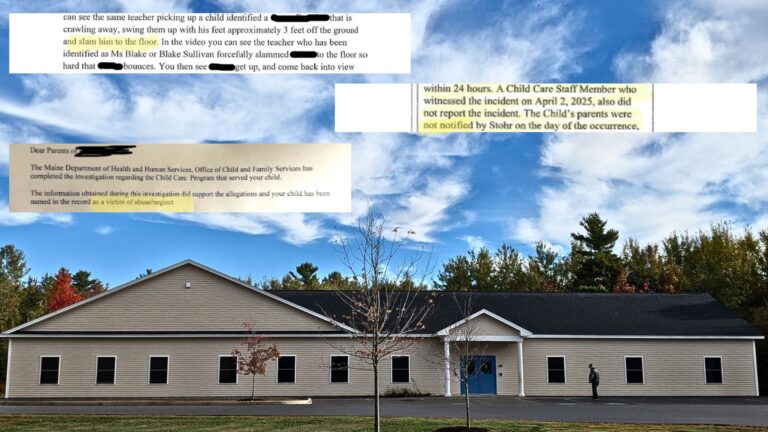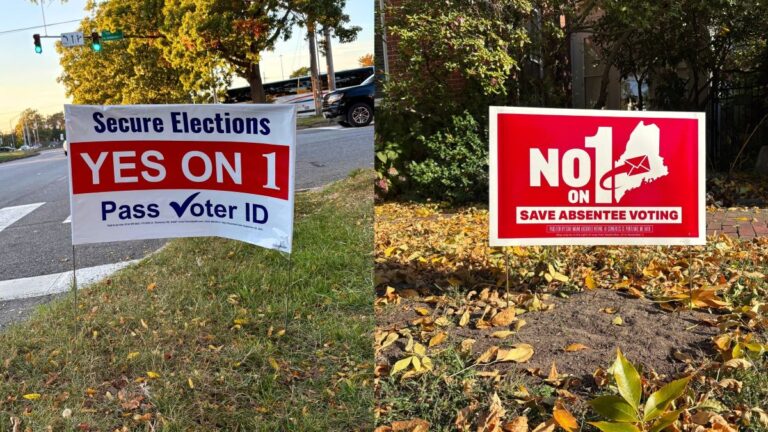The revaluation of Lubec property has once again raised concerns about how residents on stretched incomes will make ends meet and how municipalities make up for lost real estate tax revenue when a significant portion of their land is in easements that reduce or eliminate any tax revenue.
Assessor Jacqueline Robbins says that with the revaluation “not a whole lot of people had their taxes go down. A fair amount stayed the same or just went up a bit.”
However, as Lubec Community Outreach Center Director Jennifer Bristol knows, a change of $50 a year in a tax bill, which might be considered a nominal change not worth counting as an increase, can tip a person’s budget into frightening territory. The outreach center provides a number of services to the community, including a monthly food pantry.
She explained that SNAP benefits have been reduced significantly, COVID funds that helped with food and other needs have ended, and the results are that households already on the edge feel the pinch, and so do pantries and their food suppliers.
“I had one woman talk about how her SNAP benefit was reduced to $40 per month for food,” Bristol said.
Pantries were meant to supplement food budgets. They were never meant to be a grocery store for clients, she noted, but household duress has reached the point where that is what they are becoming.
A month like September, which has five weeks in it, can be a real strain for people who visit the pantry and receive supplies for four weeks. The quality of a person’s or household’s life “can be severely changed by even a $50 increase in their tax bill.”
More and more she is seeing that clients visit multiple food pantry sites to get enough food to eat.
Clients might be young adults, they might be grandparents raising grandchildren or they might be a single elder who has recently lost their partner. All share a need for resources and are seeing higher costs for food, fuel, healthcare, tax bills and more.
The potential ripple effect frightens Bristol. “Do I see a challenge out there, yes, I do. I see it from the mood, the nervousness, the sadness, the ‘I don’t know what’s going to happen’ feeling. I see real fear.”
Valuation and reimbursement are an unequal equation
For someone who has been an assessor for years, Robbins was still surprised to see how low the state reimbursement rate is for Lubec.
“On tax bills it’s required to state how the state aid has lowered the bill.” Lubec’s rate is 13%. “It kind of shocked me,” she said.
The language states, “As a result of the money our municipality receives from the state legislature through the state municipal revenue sharing program, homestead exemption and BETE (business equipment tax exemption) reimbursement and state aid for education, your property tax bill has already been reduced by…”
In Eastport the rate is 37%. Robbins has seen some remote communities in Aroostook with a rate as high as 80%, but usually it’s in the 40‑50% range, she says.
Robbins explained Lubec’s valuation went from $130 million to $220 million, and the town’s expenses increased in its annual budget. The last revaluation was in 1995. She adds while there’s no law that says a revaluation must be done every 10 years, every decade is the expectation.
“So what happens during all those years — new houses are built, existing houses are changed, and they’re all evaluated at the 1995 value until the reval takes place.”
The state requires that the revaluation be within 92‑100% of the real estate market value in order to qualify for full state reimbursement for various programs like the homestead exemption and more.
The state’s revenue sharing uses three figures to calculate the rate of reimbursement distribution: the valuation provided by the assessor, the tax assessment provided by the property tax division of Maine Revenue Services and the estimated or actual population number. The revenue sharing formula is based on the population multiplied by the assessment and then divided by the valuation.
The program is meant to help stabilize property taxes and to aid in financing municipal services.
Lubec, Robbins said, has a low population in relation to the number of houses being assessed with high valuations. The 2020 U.S. Census has the town’s population at about 1,200, and Robbins noted the town has about 1,200 houses, many of which are vacation homes. It also has over 25% of its land in tax abatement programs.
The high valuation of properties, the loss of tax revenue on conserved lands and a low population with fewer students results in a town’s education costs and the state reimbursement rate bringing a host of challenges to the municipal budget.
Former AOS 77 Superintendent Kenneth Johnson explained in February of this year, “The trouble is when property valuation is used as a measure of wealth or a town’s ability to pay. There are towns that are land rich but have a depressed economy.”
They may also have a smaller population and fewer students, which also affects the subsidy formula. “If you use property valuation as a measure of the ability to pay, it hurts small, rural areas.”
Pointing to property valuations of area municipalities, he asked rhetorically, “Does anybody think that Lubec is $17 million richer than Calais? There is no comparison in terms of the strength of the economy between those two communities.”
Yet the state education subsidies covered nearly 65% of the Calais school department’s $9.5 million budget in 2022‑23, while only providing 12% of Lubec’s $2.4 million budget and 11% of Eastport $3.2 million budget.
Loss of tax revenue with conserved lands
The Town of Lubec encompasses just about 50,000 acres. Eastport, on the other hand, encompasses 2,400 acres. Of Lubec’s acreage, at least 25% is in some kind of easement or exempt status for real estate tax purposes.
According to Robbins, the state owns almost 1,900 acres, Maine Coast Heritage Trust has 1,944 acres, Cobscook Shores has 565 acres, the Nature Conservancy has 132 acres, and then there are private landowners who might have their land in open space or other tax abatement programs.
Tax reduction on these properties can range from total exemption for Cobscook Shores to a 5% tax on lands owned by land trusts such as MCHT and the Nature Conservancy.
Many of these organizations do pay something in lieu of taxes or make other monetary donations to help the municipality.
In 2018 a meeting was held in Machias by professionals in planning, municipal government and conservation to discuss the pressures that municipalities were facing in lost tax revenue from conserved land.
Milbridge Town Manager and Washington County Budget Committee Chair Lewis Pinkham had seen how the decrease in property taxes hit municipalities twice: in their own budgets and in their share of the county’s budget. At the meeting he said, “I believe nonprofits need to pay at least 50% of the property taxes” on the valuation of the lands they own.
Former Lubec Tax Assessor Jim Clark was at the 2018 meeting. Depending on which set of tax abatement rules a property owner chooses to apply, according to Clark, the reduction in tax can range from 20% to 95%. In 2018 the town had lost about $180,000 in collectible real estate taxes, a number that was raised at the Machias meeting as an example of how conserved lands impact local budgets.
Clark noted, “The open space bar of $5 million for public town vote is too high for Washington County.” As far as he knew there had never been an open space project over $1.3 million in the county.
“They’ll never have to go before citizens” for public input on a program that has direct consequences for taxpayers, he added. Clark later explained unless the open space application exceeds 8% of the state’s valuation for the town, it doesn’t come up for public comment.
Former Washington County Council of Governments Executive Director Judy East was at the 2018 meeting and explained that both the open space and tree growth programs lower property valuations and thus real estate taxes, and while municipalities still receive some reimbursement from the state for tree growth, with the open space program “the town takes the whole hit.”
Robbins is more than aware of the issues raised at the 2018 meeting. She has discussed with the Lubec selectmen what kinds of laws might help in these situations. “Could Maine have a law that only a certain percentage of a municipality can be conserved land?”
Chebeague Island has a residential growth management ordinance, Robbins said, giving an example of how an ordinance might be used to manage aspects of municipal development.
The Chebeague ordinance spells out how many new dwellings can be built in a year as part of an effort to provide for the immediate housing needs of existing residents, ensure fairness in the allocation of building permits, provide orderly planning for the future of the community and to avoid a rapid expansion of housing that would overwhelm the town’s services.
Robbins said maybe there would be a way to create a local ordinance that spells out that only so much could be added to the base of nonprofits or conserved lands in the town. That approach “is probably less of a hill to climb than to make land trusts taxable at a certain level.”
While municipalities cannot dictate how private land is enrolled in programs that it qualifies for, such as open space and tree growth, towns and cities can use comprehensive plans to stress that certain lands are seen by citizens as important for protection and enrollment and others designated for other uses.
“I can bet that Lubec has a much higher percentage of land off the tax rolls than other shorefront communities,” Robbins guesses. It’s something she’s researching. She’s also checking to see if other wealthier communities have higher rates of payment in lieu of taxes.
As for the revaluation in Lubec, she said, “My goal was to try to get the value at 92%, not 100%, but to get as much money from the state” in reimbursement without raising tax bills too much.
This story was originally published by the Quoddy Tides, and is republished here with permission.







